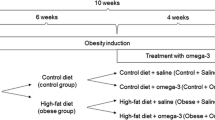Abstract
The interactive relationship between Cu deficiency and depressed synthesis of certain neurotransmitters has been recognized. To investigate the effects of dietary Cu supplementation on the catecholamine levels in genetically obese mice, male obese (ob/ob) mice and their lean (+/?) counterparts were administered either a control diet (4.0 mg/kg) or a Cu-supplemented diet (50 mg/kg) for 4 wk. The ob/ob mice that were fed a control diet showed lower liver and higher plasma levels of Cu. Depressed levels of plasma and brain catecholamines were also found in ob/ob mice that were fed the control diet. The ob/ob mice that received a Cu-supplemented diet showed significant increases in the levels of catecholamine in the plasma and brain. This study showed that catecholamine levels in ob/ob mice can be increased by dietary Cu supplementation. However, the interaction between Cu and sympathetic nervous activity in obesity was not elucidated in this study.
Similar content being viewed by others
References
C. A. Hassel, J. A. Marchello, and K. Y. Lei,J. Nutr.,113, 1081–1083 (1983).
M. Fields, R. J. Ferretti, J. C. Smith, and S. Reiser,J. Nutr.,114, 393–397 (1984).
E. D. Saggerson, S. R. Sooranna, and C. J. Evans,Biochem. J.,154, 349–357 (1976).
M. Fields, S. Reiser, and J. C. Smith,Proc. Soc. Exp. Biol. Med.,173, 137–139 (1983).
L. M. Klevay,Nutr. Rep. Int.,26, 329 (1982).
B. W. C. Lau, and L. M. Klevay,J. Nutr.,111, 1689–1703 (1981).
P. W. Harvey, and K. G. D. Allen,J. Nutr.,111, 1855–1858 (1981).
R. M. Walter, J. Y. Uriu-Hare, K. L. Olin, M. H. Oster, B. D. Anawalt, J. W. Critchfield, and C. L. Keen,Diabetes Care,14, 1050–1056 (1991).
A. Sjogren, L. Edvinsson, C. H. Floren, and M. Abdulla,Nutr. Res.,6, 147–154 (1986).
L. M. Klevay,Nutr. Rep. Int.,35, 999–1005 (1987).
H. H. Sandstead,Am. J. Clin. Nutr.,35, 809–814 (1982).
N. W. Solomons,J. Am. Coll. Nutr.,4, 83–105 (1985).
L. M. Klevay,Biol. Tr. Ele. Res.,5 245–255 (1983).
G. K. Davis, and W. Mertz, inTrace Elements in Human and Animal Nutrition, W. Mertz, ed., Academic, New York, pp. 301–364 (1987).
Anonymous,Nutr. Rev.,48, 416–418 (1990).
G. A. Bray, and D. A. York,Physiol. Rev.,59, 719–809 (1979).
P. Y. Lin, D. R. Romsos, and G. A. Leveille,J. Nutr.,107, 1715–1719 (1977).
B. E. Walker, inTechniques and Instrumentations in Analytical Chemistry, J. E. Cantle, ed.,Vol. 5, Atomic Absorption Spectrometry, Elsevier, Amsterdam, pp. 321–340 (1982).
A. Foti, S. Kimura, V. DeQuattro, and D. Lee,Clin. Chem.,33, 2209–2213 (1987).
A. Jakubovic, D. Fu, and H. C. Fibiger,J. Pharmacol. Methods,17, 1–14 (1987).
J. L. Gill, inThe Animal and Medical Sciences, Vol. 1, Iowa State Univ Press, Ames (1979).
J. M. Fledman, and J. H. Henderson,Diabetes,27, 389–395 (1978).
E. M. Stricker, and M. J. Zigmond, inNovel Approaches and Drugs for Obesity, A. C. Sullivan and S. Garattini, eds., John Libbey, London, pp. 39–50 (1985).
B. L. O'Dell,Nutr. Rev.,48, 425–434 (1990).
J. F. Lorden, G. A. Oltmans, and D. L. Margules,Brain. Res.,117, 357–361 (1976).
Author information
Authors and Affiliations
Rights and permissions
About this article
Cite this article
Lin, WH., Chen, MD., Wang, CC. et al. Dietary copper supplementation increases the catecholamine levels in genetically obese (ob/ob) mice. Biol Trace Elem Res 50, 243–247 (1995). https://doi.org/10.1007/BF02785415
Received:
Accepted:
Issue Date:
DOI: https://doi.org/10.1007/BF02785415




